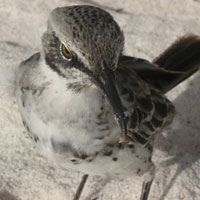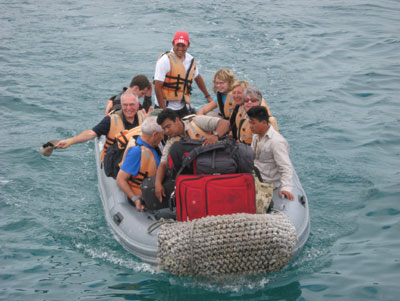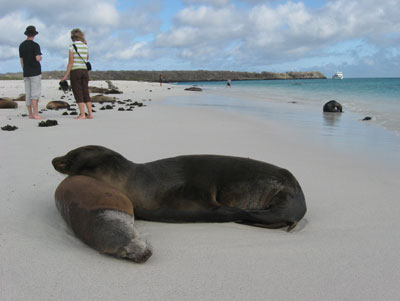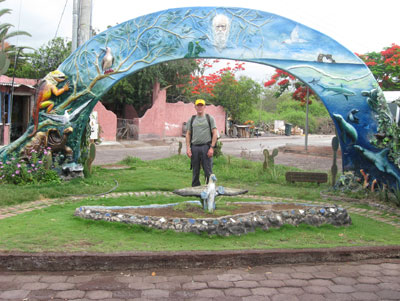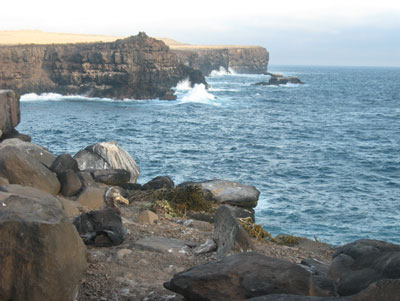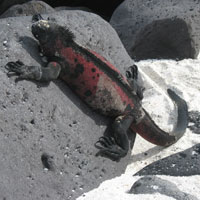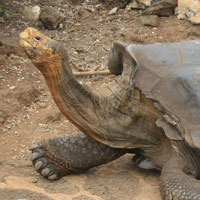Mingling with the wildlife on a Galápagos Islands cruise
by Dennis Sherwood, Gig Harbor, WA (Second of two parts)
After our 9-day birding adventure in Ecuador, we were scheduled to fly to the Galápagos Islands. However, upon arriving at the Quito airport we noticed that our flight had been dropped from the departure screen. Due to the previous night’s bad weather, nearly all flights were delayed. Meanwhile, the airport lounge was beyond full. Even pilots were hovering around an orange-vested airport worker who had a walkie-talkie mashed to his ear hoping for news.
When we finally boarded our Tame Airlines flight, we noticed that a cowling was open as a worker banged at the engine with the handle of a screwdriver — aircraft maintenance, Ecuador style.
Prior to our landing in the Galápagos, flight attendants opened the overhead luggage carriers to spray insecticide all the way down the cabin — an effort to prevent unwelcome pests from invading the islands.
Island arrival
Our plane dropped out of the clouds at a steep angle as land suddenly appeared — a sight that brought substance to the notion of these mythical isles, hummocks of dark lava and sparse gray and green vegetation surrounded by deep-blue ocean graduating to a brighter aquamarine near shore. Of the two dozen islands, five are inhabited.
Americans built the airport on Baltra Island during WWII. Warm, tropical breezes blew gently across the tarmac, and my wife, Melissa, spotted new life-list birds, a couple of Darwin’s famous finches, even before we entered the terminal to pay the park entry fee of $100 each.
Since 97% of the Galápagos is designated as national park, we had to sign an agreement to abide by the rules: no food on the islands, no removing anything, no touching the wildlife, etc.
Bags in hand, we were herded onto waiting buses. Luggage was heaped in the back as we piled in (it was standing room only) and were whisked off to a dock, loaded into Zodiac boats and motored out to the Guantanamera, our floating home for the next five days.
Our cabin’s two bunks and tiny head were so small that even while alone it was crowded. We laughed at the exit sign posted over the doorway, which was as necessary as a map in a phone booth.
Among the 16 passengers were couples from Sweden, Holland, Germany, Belgium and Florida and the four of us from Washington. All but the boat crew spoke English. Our guide, Washington, was born in the Galápagos and was trained at the Charles Darwin Research Station. He has an encyclopedic knowledge of the islands, but he shook his head when I asked if he had ever seen snow.
Setting out
After a quick lunch, we made our first wet landing from the Zodiacs at Santa Cruz Island, splashing onto a warm sandy beach the color of golden wheat to stroll past an abundance of species at arm’s length — bright lava (or Sally Lightfoot) crabs, prehistoric iguanas and improbable blue-footed boobies — while dark and crimson frigate birds soared overhead. We had definitely arrived.
Each evening, Washington gave us a review of the next day’s activities. After our first night, snorkeling the turquoise water of the Plazas Islands amongst sea lions and schools of colorful fish was on our agenda.
During our time on the ship, we were welcome to join the captain on the bridge when cruising between islands. Although Guantanamera was equipped with state-of-the-art radar, depth finders and a GPS system, there was also a crucifix and a painting of the Madonna prominently displayed, just in case everything else failed.
Magnificent frigate birds glided above the moving boat, surfing its invisible wave of air. Cruising two hours south, we landed at Santa Fe Island to walk among female sea lions and their pups while the dominant males busily patrolled offshore to protect their harems from the “losers,” as Washington called them. Being a polygamist looked like a lot of work.
Abundant cacti provided food for land iguanas that rushed at the sound of ripe fruits falling to the ground. In the water with our wetsuits, we encountered a 3-foot marine iguana chewing algae from submerged rocks. With his long tail, he wriggled back to the surface for air and headed to the sunny beach to warm himself.
Swimming with sea lions
Overnight, Guantanamera made a long, 75-mile crossing in rough seas, finally dropping anchor about 2 a.m. off Gardner Island, near the larger Española, 90 miles south of the equator. I managed to sleep amazingly well despite having to coordinate my breaths with the heaving ship.
At dawn, our tethered boat bucked like a nervous horse in the morning breeze. After breakfast we found ourselves on shore with hundreds of sea lions sprawled along the beach and thirsty Galápagos mockingbirds boldly pecking at our water bottles. One traveler offered a capful of water from her bottle, a park no-no.
More sea lions darted about while we snorkeled in the cold water of the Peruvian current around Gardner Island. We swam to the boat for a lunch of shrimp, pesto pasta, salad, fresh pineapple and cantaloupe, then, pulling anchor, crossed to nearby Española to walk among nesting blue-footed boobies and basking marine iguanas.
On lava cliffs above the sea, powerful swells crashed through a blowhole, sending explosions of spray high into the air. A lone immature albatross sat on its nest as an adult soared away from the cliff edge on its immense wings. It was a dramatic view from which it was hard to turn and walk away.
More island explorations
After a 5-hour overnight crossing to Floreana Island, we hiked past a brackish lagoon and pink flamingos to a sandy beach where sea turtles lay their eggs. There were mounds of sand on this day but no turtles.
In our wetsuits again, we rolled backward off the Zodiac into the big swells and deep water of jagged Devil’s Crown to explore a sea cave. A white-tipped shark was spotted.
Nearby Post Office Bay was an interesting historical site. Beginning 250 years ago, sailors would leave letters in a barrel there in hopes that others would carry them back home. The practice continues to this day. I left one postcard and picked up another.
With flashlights, we entered a nearby lava tube that ended in a dark subterranean pool of water.
While snorkeling off the beach, a large Pacific green turtle grazed just beneath us. Exploring these islands was like visiting a zoo without cages.
Guantanamera turned north again, cruising toward the main town of Puerto Ayora on Santa Cruz Island. Along the way, porpoises tracked us as Isabela, the Galápagos’ largest island, loomed 50 miles to the west. Hundreds of ships filled the harbor, including the stately National Geographic Explorer, a very different class of travel in which to see the Galápagos.
In the evening we went into town, a tourist strip of restaurants, bars and the ubiquitous T-shirt shops.
Back on land
After breakfast we bid good-bye to the Guantanamera and went for a visit to the Charles Darwin Research Station. Part of the national park, it provides a captive breeding program for the tortoises that are the islands’ namesake. (Galápagos, meaning “saddles” in Spanish, is a reference to the shape of their huge shells.) One old-timer, Lonesome George, is the very last of his species from Pinta Island.
A bus transported us over the top of Santa Cruz Island to its north shore. Switching to a ferry, we crossed the narrow passage back to Baltra Island then hopped another bus to the airport.
From the airport we got a final view of Daphne Island, where researchers have studied Galápagos finches for many years. Their investigation of the ongoing evolutionary process occurring there was chronicled in the 1995 Pulitzer Prize-winning book “The Beak of the Finch.”
Charles Darwin visited the Galápagos Islands for five weeks in 1835, collecting many specimens. His provocative “On the Origin of Species” was published in 1859.
Back on the mainland, the hotel’s courtesy van met us at the Quito airport.
The Galápagos portion of our trip was with Gala Cruises (Quito, Ecuador; phone +593 2 2509007, www.galacruises.com) and was arranged by Angie of Trogon Tours (Lakewood, WA; 253/512-1060, www.trogontours.net), who handled our 9-day adventure in Ecuador. She got us a really great price. Our five days cost $700 per person plus an additional $400 each for the round-trip flight from Quito.
Angie also did a superb job of communicating our return-transportation needs to the predominantly Spanish-speaking hotel staff before we parted company.
Heading from the airport to the familiar Akros, where we had stayed prior to visiting the Galápagos Islands, the drive in the afternoon traffic took longer (1½ hours) than it took to fly from the Galápagos.
By 4 a.m. the next day, we loaded into a taxi and headed for the airport. What happened next could have been scripted from “The Wind in the Willows” — an Ecuadorian rendition of Mr. Toad’s wild ride through the empty, early-morning streets of Quito, speeding through red lights, skidding on rain-soaked asphalt, squealing around corners and swerving around a wrong-way driver heading straight at us, G-forces piling up all the while! How were we to tell the Spanish-speaking driver that we were not late, that there was no need to hurry?
Our taxi finally slammed to a stop at the airline terminal, and I could have sworn that the time on my watch was earlier than when we had left the hotel! Throwing open the door to escape, we tumbled out feeling wobbly and dazed. Ecuadorian time travel will do that to you.


